Get Tech Tips
Subscribe to free tech tips.
Fancy Refrigerant Words

The HVAC industry uses all sorts of fancy words to classify refrigerant. As such, there are all sorts of complicated refrigerant acronyms: HFC, HCFC, CFC. Let's also not forget the mythical zeotropic, azeotropic, and near-azeotropic descriptors. Let's simplify those. (Though if you want to go back to the basics first, check out this article on refrigerant basics.)
CFC, HCFC, and HFC

CFC – Refrigerants that are really bad for the ozone layer. They are almost all gone. R-12 and R-11 are examples.
HCFC – Refrigerants that are bad for the ozone layer but not as bad as CFCs. The most common example is R-22, which is no longer being manufactured in or imported into the United States. (Unsurprisingly, R-22 is very expensive nowadays. If you plan to retrofit an R-22 system, you might want to consider reading about some of our retrofit tips.)
HFC – Refrigerants that aren't bad for the ozone layer, but they add to global warming through the greenhouse effect. The most common one is R-410a, which has a global warming potential (GWP) of 2088. The high-GWP HFCs are entering a phase-down in the United States. For more information about the HFC regulations and refrigerant replacements, please listen to one of our live podcasts from AHR with Jason Obrzut. You may also want to visit the webpage for AHRI's Safe Refrigerant Transition Task Force. R-32, a replacement for R-410A, is also an HFC but has a much lower GWP than R-410A.
Zeotropic/Azeotropic
When it comes to the whole zeotropic/azeotropic classification system, the main thing you need to know is that older refrigerants were often just one type of molecule. That meant that they condensed and evaporated consistently, and it didn't matter if you added them to the system as vapor or liquid. These simple refrigerants were known as PURE refrigerants.
Today, we mostly work with HFC and HCFC blends (though HFOs may also step up to the plate to replace the refrigerants being phased out). These blends can be azeotropic, which means they blend together and act as one refrigerant. Otherwise, they can be zeotropic, which means they have something called “glide.”
Glide refers to the boiling/condensing temperature range resulting from the different boiling and condensing temperatures of the refrigerants in the mix. Rubber meets the road in a refrigerant with high glide when you need separate “condensing” and “boiling” temperatures on the PT chart. R-407C is an example of a high-glide zeotropic refrigerant, whereas R-410a has very little glide. While R-410a is TECHNICALLY zeotropic, it is so close to being azeotropic that the industry coined the phrase “near-azeotropic.”

In all blends, you must charge the refrigerant as a liquid to prevent the refrigerants from separating in the vapor state. You usually have to invert the tank, and you may also need to use a charging orifice. As always, when charging liquid in the suction line, add it slowly and carefully, allowing all the liquid to boil off before entering the compressor to prevent flooding/slugging.
—Bryan











Comments
To leave a comment, you need to log in.
Log In